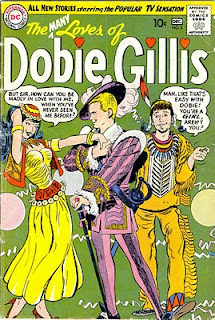For this final look at beatniks as they appeared in early 1960s American comic books, here's another page (below) from a Bob Oksner DC comic, The Many Loves of Dobie Gillis 1 (May/June 1960). It shows Dobie's Beatnik buddy, Maynard, with his tendency to walk around lost in the music that's going on inside his head. While not unkind, this typically in one sense detached-from-reality image of the beatnik found in the comics of the early 60s suggests individuals not in tune with mainstream society, but instead seeking an alternate world view on their own terms. On this page from Dobie Gillis 1, Maynard's tapping on the store window frame is mirrored by Dobie tapping him on his shoulder to break his internal musical reverie and bring him back out into the 'real' world of the rest of humanity.

Unusually, in Dobie Gillis 1, there is also a four page Maynard story, featuring a female beatnik friend of Maynard as well. Unfortunately the non-conformity of this pair of beats comes back on Maynard, who suffers humiliation as a consequence of failing to observe acceptable driving etiquette. There's a subtle message here, that okay you beatniks are free to be 'different' if you want, but if you don't conform to societal norms that really matter to the rest of us, you are going to be sorry. This fits in with the general image that seems to be presented of the beatnik - basically a bunch of people struggling to find their identity, not getting 'with it' in terms of society's expectations, and being seen as failures or bums as a result, laughable because of their choice to take a different route.
Taking this deadbeat view of beatniks to the extreme, Mad (of course) re-writes 'My Fair Lady' into the story of a beatnik that one corporate guy challenges another to transform into an advertising man, again suggesting that the beatnik is seen (by society and not necessarily by Mad) as the lowest of the low. Somehow the conversion of the beatnik into a manipulative money-maker is seen as desirable from society's point of view, rather than accepting Irving Mallion (played by a cartoon of Frank Sinatra) as a valuable free-thinking individual in his own right. The satire here is all directed at the topsy-turvy value system by which western society is run. This from Mad 54 (April 1960), with art my Mort Drucker and written by Nick Megliola.
What we've seen over the last three Out Of This World posts is the image of a very recognizable sub-culture, complete with its own linguistics, behaviors, appearance, paraphernalia, and art forms. Certainly some of what constituted beat culture is still with us today, following its re-absorption into the mainstream. One final example of the late 50s/early 60s comic book fascination with beatniks, again from Mad (#49, September 1959), is this beat translation of Lincoln's Gettysburg Address, with art again by Mort Drucker:
Finally, a request from Out Of This World to anyone who reads this. I have for many years been searching for a particular Archie (or Jughead or similar) comic that I had when I was a kid in the 1960s. Somewhere in the comic, Archie introduces a beatnik Jughead to his father, and Jughead responds with the following (that I memorized at the time and have never forgotten):
"Endsville, Daddy-o! Lend me some skin, man! Your heir's a gasser. I dig him the most."
Archie translates this for his father as, "Good afternoon, Sir! Pleased to meet you! You have a fine son. I like him a lot."
At the time I literally couldn't stop laughing when I read this, and kept looking at it over and over and collapsing on the floor in fits of uncontrollable mirth. Although I doubt I could quite recreate the same intense reaction now, I would still really like to get a copy of whatever comic that was. If anyone out there can tell me which issue it is that I'm looking for I would be very happy!


































































